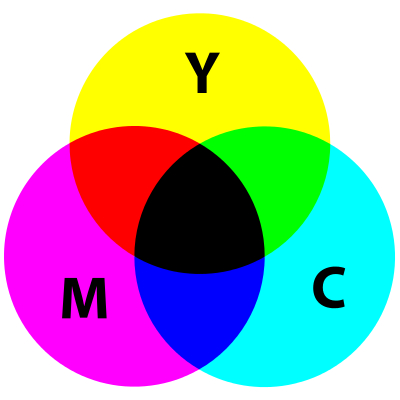


A color wheel or color circle[1] is an abstract illustrative organization of color hues around a circle that shows relationships between primary colors, secondary colors, tertiary colors etc. wiki>

Primary colors are sets of colors that can be combined to make a useful range of colors. For human applications, three primary colors are usually used, since human color vision is trichromatic. wiki>

A secondary color is a color made by mixing two primary colors in a given color space. wiki>

A tertiary color or quaternary color (called intermediate colors) is a color made by mixing either one primary color with one secondary color, or two secondary colors, in a given color space. wiki>
Color scheme is choise of colors that together creates aesthetic feeling. There are several types od color shemes defined by color rules.

The triadic color scheme uses three colors equally spaced around the color wheel. The easiest way to place them on the wheel is by using a triangle of equal sides. Triadic color schemes tend to be quite vibrant, even when using pale or unsaturated versions of hues, offers a higher degree of contrast while at the same time retains the color harmony.

Complementary (opposite) colors are pairs of colors which, when combined, cancel each other out. This means that when combined, they produce a grey-scale color like white or black.[1] When placed next to each other, they create the strongest contrast for those particular two colors wiki>

Analogous colors (also called Dominance Harmony) color scheme are groups of colors that are adjacent to each other on the color wheel, with one being the dominant color, which tends to be a primary or secondary color, and two on either side complementing, which tend to be tertiary. wiki>

Compound colors are like complementary colors but, there are more pairs of colors

A color model is an abstract mathematical model describing the way colors can be represented as tuples of numbers, typically as three or four values or color components. wiki>

Contrast is the difference in luminance or color that makes an object (or its representation in an image or display) distinguishable. wiki>

Colorfulness is the degree of difference between a color and gray. Chroma is the colorfulness relative to the brightness of another color that appears white under similar viewing conditions. Saturation is the colorfulness of a color relative to its own brightness. wiki>

The RGB color model is an additive color model in which red, green, and blue light are added together in various ways to reproduce a broad array of colors. wiki>

The CMYK color model (process color, four color) is a subtractive color model, used in color printing, and is also used to describe the printing process itself. CMYK refers to the four inks used in some color printing: cyan, magenta, yellow, and key (black). wiki>

HSV (hue-saturation-value) is one of the most common cylindrical-coordinate representations of points in an RGB color model. Color space is defined by hue saturation and value.
wiki>
[ Own work, Author: SharkD, CC BY-SA 3.0]

A Lab color space is a color-opponent space with dimension L for lightness and a and b for the color-opponent dimensions, wiki> [Own work, Author: Jacobolus, CC BY-SA 3.0]